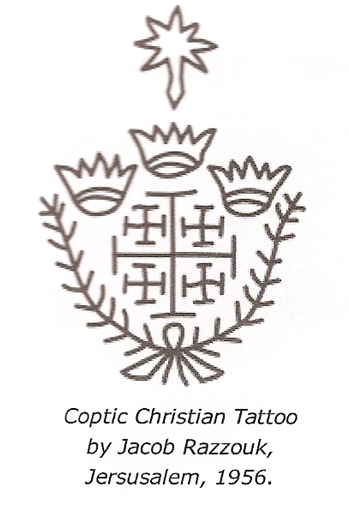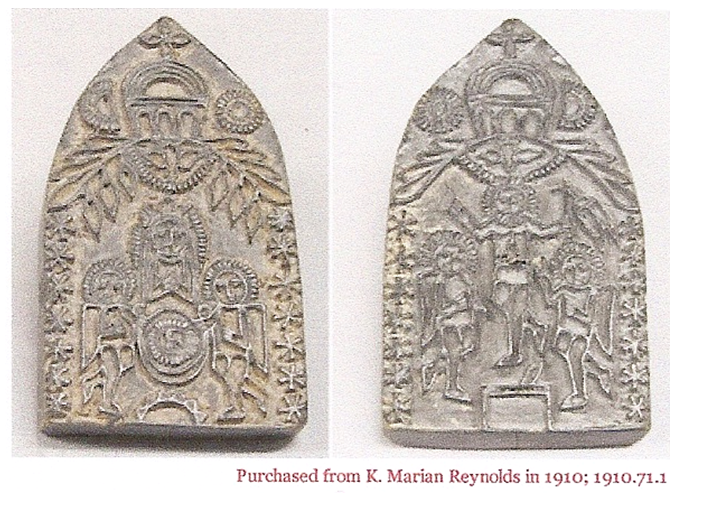Pilgrimage Tattoos
Magistra Rosemounde of Mercia (copyright Micaela Burnham 2014)
History of Tattoos: Tattooing existed in many cultures around the world that had no contact with each other since early times. In almost all cases, it is believed to have been a religious right, although it may also have been a way of identify the family or rank of the wearer. The word tattoo comes from the Polynesian word “tatau,” and was first heard by a European when Captain Cook went to the islands in the 18th century. Various words have been used to describe it in various cultures. In fact, there are so many, it is often difficult to distinguish whether tattooing, branding, scarification, or merely painting is being referenced except though context. Tattooing was known early on by western and middle-eastern cultures. The Romans tattooed slaves to mark them as property, and facial tattooing was used as a form of punishment. Tattoos among the Arab tribes were also seen, and probably had significant meanings as to family lineage.
Religion and tattooing: Tattooing was well known among pagan tribes, and many tattoos had religious significance, whether in Bulgaria, Armenia, Egypt, or in pagan Britain. Although Leviticus 19:28 forbids tattooing; “Ye shall not make any cuttings in your flesh for the dead, nor print any marks upon you.” as a crime against God (an abomination), this was one of the many ways in which the ancient Jews separated themselves from the pagan cultures they wished to conquer and supplant. Orthodox Jews still follow these injunctions, as they do the rest of Leviticus. It has been argued that Paul’s statement in Galations 6:7 “for I bear upon my body the marks of the Lord Jesus” may have been referring to a tattoo. It is believed that early Christians tattooed themselves with religious symbols such as the cross, the fish, and the chi-rho. In 307 AD, the Emperor Constantine, who had converted to Christianity, outlawed facial tattooing because he said the human face was made in the image of God. This simply banned the use of tattooing the face as a punishment. However by 787 AD the Christian church in the Council of Northumberland issued an edict saying, “When an individual undergoes the ordeal of tattooing for the sake of God, he is greatly praised. But one who submits himself to be tattooed for superstitious reasons in the manner of the heathens will derive no benefit there from.” The German mystic Heinrich Suso (1295-1366) had the Jesus name tattooed over his heart, and tattooing may have been a part of exorcism rituals.
Pilgrimage tattoos: Thus began to pilgrimage tattoo. By the middle ages tattoos worn as a sign of faith were being seen on clerics, but most notably on pilgrims and crusaders to the Holy Land. The most popular tattoo was the cross. Getting a tattoo was seen as a “small martyrdom—a public shedding of blood.” Seen as akin to Christ’s crown of thorns, it was a way for the devout to take up the cross and suffer pain in the holy places where Christ has suffered. Crusaders of the 11th-13th centuries in particular branded, scarified, or tattooed themselves upon reaching Jerusalem. Eastern Christians, Copts, Ethiopians, and Armenians in particular were passionate about tattoos upon completing the pilgrimage and even got crosses tattooed on their foreheads. A 1484 Catholic Church document refers to “branding marks” for pilgrims. By the 1500s pilgrimage tattoos are well documented. The Jerusalem cross, the virgin Mary, and religious scenes were common tattoos. Whether tattoos were also done for pilgrimages to other places than Jerusalem is unknown at this time. There is still a family in Jerusalem doing pilgrimage tattoos today. They have been doing tattooing there for at least 200 years, as one of their wooden stamps is dated. The tradition in their family is that a Coptic ancestor set up shop there is the 1600.
The tattooing process in period: Even in early cultures, intricate designs were tattooed, so a certain amount of sophistication in the art was possible from very early times. There are two ways to tattoo: the first is to make a cut with a sharp blade and rub ink or powdered charcoal into the cut, the second is to use and ink impregnated needle as is still done today. The first method is only good for simple line drawings, and does not last as long. The use of a needle, held at the precise point where it penetrates deep enough to leave a permanent mark, but not so deeply that there is an excess of blood, can be used for intricate detailed artwork. In period, a carved wood stamp was inked and used to mark the design on the skin. Some of these from the 1500s are still extant. However, no other tattooing equipment has survived. Despite this, we are fairly certain that the methods used throughout the world, which are very similar to each other, was the method of choice. A needle is placed through a small slat of wood to a precise distance, dipped into ink or paint, and then tapped along the printed line. It is believed that most pilgrimage tattoos were line drawings without filled in color within SCA periods, as that technique did not appear in many cultures within SCA periods.
Bibliography
The Decorated Body, by Robert Brain, 1983, ISBN-10: 0060104589
Pitt Rivers Museum of Body Arts, http://web.prm.ox.ac.uk (Oxford University)
http://www.tattoosymbol.com
http://www.catholicnews.com
http://www.smissourian.com
Magistra Rosemounde of Mercia (copyright Micaela Burnham 2014)
History of Tattoos: Tattooing existed in many cultures around the world that had no contact with each other since early times. In almost all cases, it is believed to have been a religious right, although it may also have been a way of identify the family or rank of the wearer. The word tattoo comes from the Polynesian word “tatau,” and was first heard by a European when Captain Cook went to the islands in the 18th century. Various words have been used to describe it in various cultures. In fact, there are so many, it is often difficult to distinguish whether tattooing, branding, scarification, or merely painting is being referenced except though context. Tattooing was known early on by western and middle-eastern cultures. The Romans tattooed slaves to mark them as property, and facial tattooing was used as a form of punishment. Tattoos among the Arab tribes were also seen, and probably had significant meanings as to family lineage.
Religion and tattooing: Tattooing was well known among pagan tribes, and many tattoos had religious significance, whether in Bulgaria, Armenia, Egypt, or in pagan Britain. Although Leviticus 19:28 forbids tattooing; “Ye shall not make any cuttings in your flesh for the dead, nor print any marks upon you.” as a crime against God (an abomination), this was one of the many ways in which the ancient Jews separated themselves from the pagan cultures they wished to conquer and supplant. Orthodox Jews still follow these injunctions, as they do the rest of Leviticus. It has been argued that Paul’s statement in Galations 6:7 “for I bear upon my body the marks of the Lord Jesus” may have been referring to a tattoo. It is believed that early Christians tattooed themselves with religious symbols such as the cross, the fish, and the chi-rho. In 307 AD, the Emperor Constantine, who had converted to Christianity, outlawed facial tattooing because he said the human face was made in the image of God. This simply banned the use of tattooing the face as a punishment. However by 787 AD the Christian church in the Council of Northumberland issued an edict saying, “When an individual undergoes the ordeal of tattooing for the sake of God, he is greatly praised. But one who submits himself to be tattooed for superstitious reasons in the manner of the heathens will derive no benefit there from.” The German mystic Heinrich Suso (1295-1366) had the Jesus name tattooed over his heart, and tattooing may have been a part of exorcism rituals.
Pilgrimage tattoos: Thus began to pilgrimage tattoo. By the middle ages tattoos worn as a sign of faith were being seen on clerics, but most notably on pilgrims and crusaders to the Holy Land. The most popular tattoo was the cross. Getting a tattoo was seen as a “small martyrdom—a public shedding of blood.” Seen as akin to Christ’s crown of thorns, it was a way for the devout to take up the cross and suffer pain in the holy places where Christ has suffered. Crusaders of the 11th-13th centuries in particular branded, scarified, or tattooed themselves upon reaching Jerusalem. Eastern Christians, Copts, Ethiopians, and Armenians in particular were passionate about tattoos upon completing the pilgrimage and even got crosses tattooed on their foreheads. A 1484 Catholic Church document refers to “branding marks” for pilgrims. By the 1500s pilgrimage tattoos are well documented. The Jerusalem cross, the virgin Mary, and religious scenes were common tattoos. Whether tattoos were also done for pilgrimages to other places than Jerusalem is unknown at this time. There is still a family in Jerusalem doing pilgrimage tattoos today. They have been doing tattooing there for at least 200 years, as one of their wooden stamps is dated. The tradition in their family is that a Coptic ancestor set up shop there is the 1600.
The tattooing process in period: Even in early cultures, intricate designs were tattooed, so a certain amount of sophistication in the art was possible from very early times. There are two ways to tattoo: the first is to make a cut with a sharp blade and rub ink or powdered charcoal into the cut, the second is to use and ink impregnated needle as is still done today. The first method is only good for simple line drawings, and does not last as long. The use of a needle, held at the precise point where it penetrates deep enough to leave a permanent mark, but not so deeply that there is an excess of blood, can be used for intricate detailed artwork. In period, a carved wood stamp was inked and used to mark the design on the skin. Some of these from the 1500s are still extant. However, no other tattooing equipment has survived. Despite this, we are fairly certain that the methods used throughout the world, which are very similar to each other, was the method of choice. A needle is placed through a small slat of wood to a precise distance, dipped into ink or paint, and then tapped along the printed line. It is believed that most pilgrimage tattoos were line drawings without filled in color within SCA periods, as that technique did not appear in many cultures within SCA periods.
Bibliography
The Decorated Body, by Robert Brain, 1983, ISBN-10: 0060104589
Pitt Rivers Museum of Body Arts, http://web.prm.ox.ac.uk (Oxford University)
http://www.tattoosymbol.com
http://www.catholicnews.com
http://www.smissourian.com


